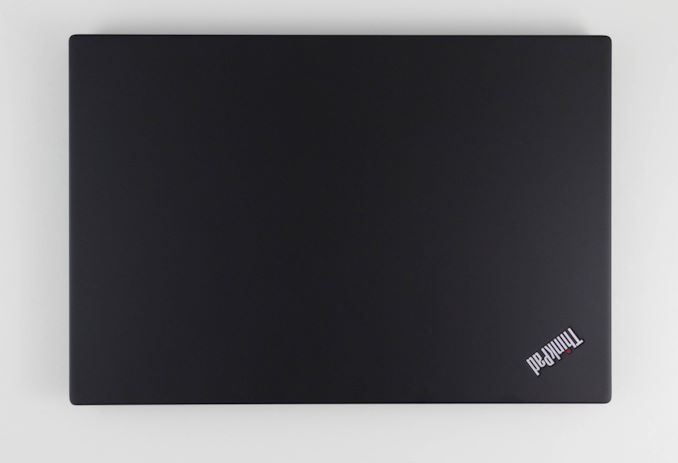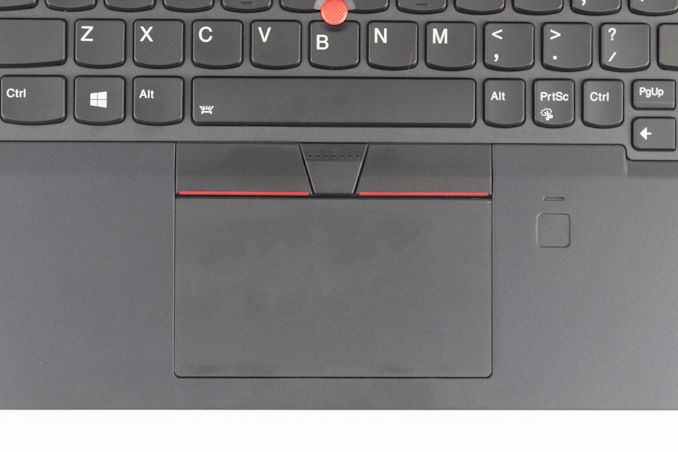The Lenovo ThinkPad A285 (12.5-Inch) Review: Ryzen Pro Gets Down to Business
by Brett Howse on December 18, 2018 8:00 AM EST- Posted in
- Laptops
- AMD
- Lenovo
- ThinkPad
- Vega
- Ryzen
- Ryzen PRO
- Ryzen Mobile
- Vega Mobile
Design
The ThinkPad is an iconic look at this point, and Lenovo has done well to constantly update and refresh the design without losing that ThinkPad look. The matte black is exactly what people expect, along with the red LED dot over the i on the back. The ThinkPad A285 is basically the same chassis as the Lenovo ThinkPad X280, with the same dimensions, same weight, and same strong build.
Despite the 12.5-inch display being smaller than a 13.3-inch model, this model hasn’t gotten the slim bezel treatment yet, so it definitely looks a bit more dated than slimmed down bezels in the ThinkPad X1 Carbon, and therefore the footprint of the 12.5-inch A285 is not quite as small as you may think. Still, it is quite compact, and thin at 17.4 mm where it isn’t going to take up a lot of room in a bag.
Lenovo offers some of the best keyboards around on the ThinkPad lineup, and the A285 offers that same sculpted key feel that they do so well. The keys themselves have good travel, and offer just enough resistance to feel right. The keyboard offers a couple of levels of white backlighting, which contrasts well with the black keys with white letters. Lenovo reverses the Fn and Ctrl keys on all of their ThinkPad keyboards, but that’s only really an issue if you’re coming from a different brand. Luckily if you don’t want to unlearn your muscle memory, you can reverse them in software.
Lenovo utilizes the Microsoft Precision touchpad drivers, and the touchpad, while not as silky smooth as some of its competition, still offers great response, and seems to pick up multiple finger inputs with no issues. For those that prefer the TrackPoint, that is available as well, and would be sorely missed if Lenovo ever decides to do away with it.
The left side offers the two USB-C ports, with one integrated into the docking connection, which also offers the native Ethernet dongle attachment. The USB-A ports are split between both sides, with the right side offering the always-on version. There’s of course a 3.5 mm headset jack, and HDMI on the left. If you order a model with a smart card reader, that would be located on the right. On the rear is a microSD storage expansion slot.
There’s been an unfortunate tendency for AMD’s processors to find their way into value devices, but the ThinkPad A285 breaks that pattern, as it's basically the same chassis as their Intel-based X280, just with different internals. The result is a well-built, premium business device which happens to offer AMD's Ryzen Pro. So IT administrators will love it because it's as classic a ThinkPad as they come, while enthusiasts will be keen to see what AMD can do in a business-grade laptop.















72 Comments
View All Comments
jardows2 - Tuesday, December 18, 2018 - link
This chassis is not too thin for an Ethernet port. Our organization just ordered in a bunch of HP probook 450's that are every bit as thin as this, and they all include an Ethernet port. To make Ethernet connectivity a dongle is just a stupid business decision made by Lenovo for this class of laptop.HStewart - Tuesday, December 18, 2018 - link
It not that thin of notebook, it include Type-A USB so it still fat notebook - I would think it possible to include ethernet at back part of it - probably a cost saving measure - just like the display.IGTrading - Tuesday, December 18, 2018 - link
I find it ridiculous that the reviewers felt the unexplained need of including 15" laptops and notebooks with a discrete video card and compared them with a 12.5" Thin&Light portable without a discrete GPU.Why the heck are we comparing plums to grapes and apples to pineapples ?!
The most basic journalistic "rules" for an initial review are to compare products priced similarly and of course, products with comparable specifications.
Does anybody care to compare a Lamborghini to a Ford K ? Sure those are both cars, both use petrol and both have 4 wheels ... but really !?!
You want to have an expert comparison between similar products from DIFFERENT product lines .... to show just how much extra performance does a larger chassis bring ... or a higher price ... ok, do it and present it as such.
Here's a 12" ThinkPad with X CPU vs a 15" ThinkPad with the same X CPU (or similar) and here is the extra performance the larger and more expensive product gets you.
But why the heck would you compare a 15" Microsoft Surface 2 with a discrete GPU costing 2300 USD with a 12.5" ThinkPad with just an APU (no discrete GPU) costing half the price ?!?!
Is this to bury the good test results of Lenovo's AMD-based ThinkPad and make it look mediocre ?!
If Ford launches a new Ford K ... what kind of reviewer will compare it and test it against the newest Ferrari ?!
This is being forced (on all reviewers) by Intel's PR team. You either do it, or next time you have ZERO access to anything Intel-related. (happened to me too, many years ago)
nico_mach - Tuesday, December 18, 2018 - link
It doesn't seem to have a great analogue in these numbers, true. But it is very close to the Surface Pro i5 results, which is much thinner and lighter, so it still doesn't look good. Unfortunately, the prices aren't listed in these performance results - so the dGPU and i7 that look so good aren't really in the same league, but we don't know by how much.The results are unfortunate, but this is still progress by AMD, considering where they were 2 years ago. And getting Intel to respond the way they have - buying AMD graphics, matching their core counts, moving on with a hybrid 10nm scheme - really shows how competitive they've become. And when was the last time Intel had to resort to dirty tricks? Unfortunately I think both Intel and AMD should worry more about Quallcomm and Apple than each other. This comparison is ultimately irrelevant.
DanNeely - Tuesday, December 18, 2018 - link
Adding the 1060 was arguably gratuitous; but all the fanboiing on the Ryzen mobile had been about how it was going to crush the competition so Intel's mainstream parts and NVidia's entry level MX150 are entirely appropriate. And Lenovo's performance here is just awful. With 8 clusters of GPU cores instead of 10 it should be able to do at least 80% of the performance of the 15W Ryzen 7 in the Swift 3 (and a bit closer should be expected since it can use its TDP to clock the GOU higher); but instead it's coming in around 2/3rds.StevoLincolnite - Tuesday, December 18, 2018 - link
There is allot of issues in regards to Ryzen mobile, drivers and TDP.In some instances, limiting the CPU will allow the GPU in the 2500u to run faster than the 2700u.
I have the Lenovo E585 myself with a Ryzen 2700u. - It does Overwatch, 60fps, 1080P at 56% scaling all settings low.
The driver situations is certainly bullshit though, my notebooks drivers are months out of date... AMD doesn't offer any newer revision... And if I "work around" the drivers and install unofficial ones, windows update will override it at a later date and downgrade them.
I honestly expected more out of it... Going to upgrade the Ram to 16GB with lower latencies and hope that might make a small difference. My next notebook will certainly have a discreet GPU.
IGTrading - Wednesday, December 19, 2018 - link
Yes, the mobile driver for Ryzen needs work and needs it quick. If OEMs don't give a crap about their customers and offer no decent support, AMD should step in with a Beta mobile driver. Doesn't need to be WHQL, doesn't need anything special ... just offer it.As for testing in exactly the same conditions, HP x360 has Ryzen and Intel models in the same chassis. When tested these two, AMD Ryzen trounced the Intel model.
Hul8 - Tuesday, December 18, 2018 - link
It's helpful to have the *one* token example with a discrete GPU, so readers can tell how much you give up by going integrated. Otherwise the review would be in a bubble of similarly handicapped systems.HStewart - Tuesday, December 18, 2018 - link
My comment was nothing about Intel - your response falsely assume it was.Most notebook users use notebook for word processing, spreadsheets and such and don't need descret CPU.
What does the GPU matter in comment about USB Size? I had to look up the specs to see what specs it had - is Vega 8 even descrete GPU? it not part of discussion - just falsely assume it was bias statement.
MonkeyPaw - Tuesday, December 18, 2018 - link
I agree when it comes to some of the performance tests. The dGPU model really skews the graphs by being so much better than iGPU models. Makes a comparison of similar models harder to do.